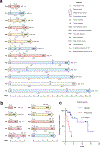Invasive Mucinous Adenocarcinomas With Spatially Separate Lung Lesions: Analysis of Clonal Relationship by Comparative Molecular Profiling
- PMID: 33839364
- PMCID: PMC8240964
- DOI: 10.1016/j.jtho.2021.03.023
Invasive Mucinous Adenocarcinomas With Spatially Separate Lung Lesions: Analysis of Clonal Relationship by Comparative Molecular Profiling
Abstract
Introduction: Pulmonary invasive mucinous adenocarcinomas (IMAs) often present with spatially separate lung lesions. Clonal relationship between such lesions, particularly those involving contralateral lobes, is not well established. Here, we used comparative genomic profiling to address this question.
Methods: Patients with genomic analysis performed on two IMAs located in different lung regions were identified. Molecular assays included DNA-based next-generation sequencing (NGS) for 410 to 468 genes (Memorial Sloan Kettering-Integrated Mutation Profiling of Actionable Cancer Targets), RNA-based NGS for 62 genes (Memorial Sloan Kettering-Fusion), or non-NGS assays.
Results: Comparative genomic profiling was performed on two separate IMAs in 24 patients, of whom 19 had contralateral lesions. Tumors from all but one patient shared matching driver alterations, including KRAS (n = 19), NRG1 (n = 2), ERBB2 (n = 1) or BRAF (n = 1). In addition, in patients with paired tumors profiled by NGS (n = 12), shared driver alterations were accompanied by up to 4 (average 2.6) other identical mutations, further supporting the clonal relationship between the tumors. Only in a single patient separate IMAs harbored entirely nonoverlapping mutation profiles, supporting clonally unrelated, distinct primary tumors. Notably, in a subset of patients (n = 3), molecular testing confirmed a clonal relationship between the original resected IMAs and subsequent contralateral IMA presenting after an extremely long latency (8.1-11.7 y).
Conclusions: Comparative molecular profiling supports that nearly all separate pulmonary IMA lesions represent intrapulmonary spread arising from a single tumor and documents a subset with a remarkably protracted course of intrapulmonary progression. This study reinforces the unique biology and clinical behavior of IMAs while further highlighting the value of genomic testing for clarifying the clonal relationship between multiple lung carcinomas.
Keywords: Comparative molecular profiling; Invasive mucinous adenocarcinoma; KRAS; Lung; Molecular diagnostics; NSCLC.
Copyright © 2021 International Association for the Study of Lung Cancer. Published by Elsevier Inc. All rights reserved.
Conflict of interest statement
The authors have no relevant conflicts of interest pertaining to this work.
Figures



Comment in
-
Genomically Metastatic, but Surgically Curable?J Thorac Oncol. 2022 Apr;17(4):e49-e50. doi: 10.1016/j.jtho.2021.07.037. J Thorac Oncol. 2022. PMID: 35307110 No abstract available.
-
Molecular Testing Identifies Ultra-Late Recurrences in Lung Carcinomas: Implications for Clinical Management.J Thorac Oncol. 2022 Apr;17(4):e50-e51. doi: 10.1016/j.jtho.2021.12.012. J Thorac Oncol. 2022. PMID: 35307111 No abstract available.
References
-
- Kadota K, Yeh YC, D’Angelo SP, et al. Associations between mutations and histologic patterns of mucin in lung adenocarcinoma: Invasive mucinous pattern and extracellular mucin are associated with KRAS mutation. Am J Surg Pathol. 2014;38(8):1118–1127. doi:10.1097/PAS.0000000000000246 - DOI - PMC - PubMed
-
- Russell PA, Wainer Z, Wright GM, Daniels M, Conron M, Williams RA. Does lung adenocarcinoma subtype predict patient survival?: A clinicopathologic study based on the new international association for the study of lung cancer/American thoracic society/European respiratory society international multidisciplinary lung adenocarcinoma classification. J Thorac Oncol. 2011;6(9):1496–1504. doi:10.1097/JTO.0b013e318221f701 - DOI - PubMed
-
- Travis WD, Brambilla E, Burke AP, Marx A, Nicholson AG. WHO Classification of Tumours of the Lung, Pleura, Thymus and Heart. Fourth Edition. Volume 7. International Agency for Research on Cancer; 2015. - PubMed
Publication types
MeSH terms
Grants and funding
LinkOut - more resources
Full Text Sources
Other Literature Sources
Medical
Research Materials
Miscellaneous

